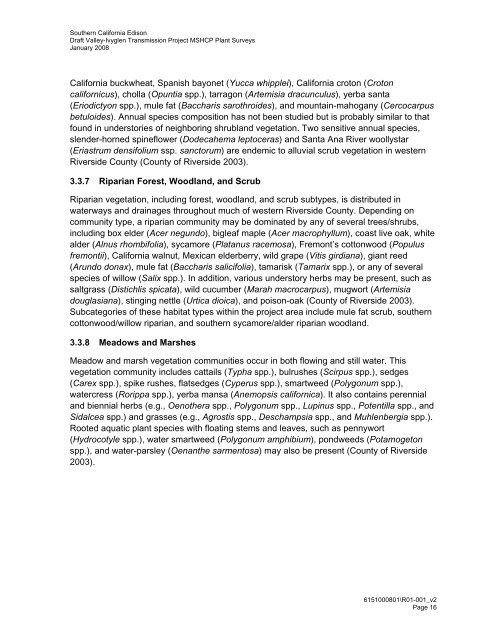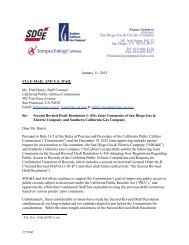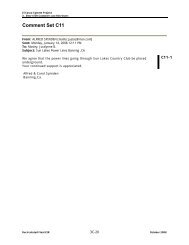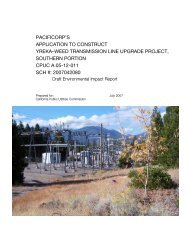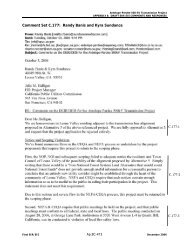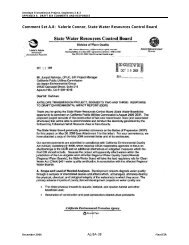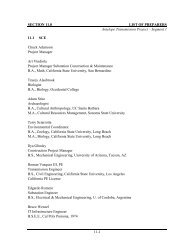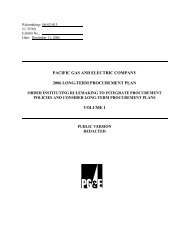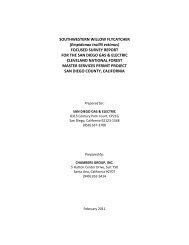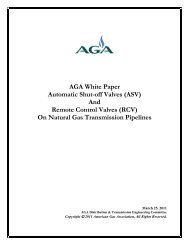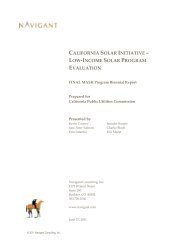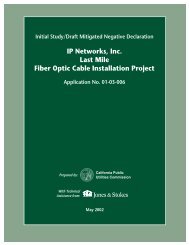draft mshcp narrow endemic and criteria area ... - State of California
draft mshcp narrow endemic and criteria area ... - State of California
draft mshcp narrow endemic and criteria area ... - State of California
Create successful ePaper yourself
Turn your PDF publications into a flip-book with our unique Google optimized e-Paper software.
Southern <strong>California</strong> Edison<br />
Draft Valley-Ivyglen Transmission Project MSHCP Plant Surveys<br />
January 2008<br />
<strong>California</strong> buckwheat, Spanish bayonet (Yucca whipplei), <strong>California</strong> croton (Croton<br />
californicus), cholla (Opuntia spp.), tarragon (Artemisia dracunculus), yerba santa<br />
(Eriodictyon spp.), mule fat (Baccharis sarothroides), <strong>and</strong> mountain-mahogany (Cercocarpus<br />
betuloides). Annual species composition has not been studied but is probably similar to that<br />
found in understories <strong>of</strong> neighboring shrubl<strong>and</strong> vegetation. Two sensitive annual species,<br />
slender-horned spineflower (Dodecahema leptoceras) <strong>and</strong> Santa Ana River woollystar<br />
(Eriastrum densifolium ssp. sanctorum) are <strong>endemic</strong> to alluvial scrub vegetation in western<br />
Riverside County (County <strong>of</strong> Riverside 2003).<br />
3.3.7 Riparian Forest, Woodl<strong>and</strong>, <strong>and</strong> Scrub<br />
Riparian vegetation, including forest, woodl<strong>and</strong>, <strong>and</strong> scrub subtypes, is distributed in<br />
waterways <strong>and</strong> drainages throughout much <strong>of</strong> western Riverside County. Depending on<br />
community type, a riparian community may be dominated by any <strong>of</strong> several trees/shrubs,<br />
including box elder (Acer negundo), bigleaf maple (Acer macrophyllum), coast live oak, white<br />
alder (Alnus rhombifolia), sycamore (Platanus racemosa), Fremont’s cottonwood (Populus<br />
fremontii), <strong>California</strong> walnut, Mexican elderberry, wild grape (Vitis girdiana), giant reed<br />
(Arundo donax), mule fat (Baccharis salicifolia), tamarisk (Tamarix spp.), or any <strong>of</strong> several<br />
species <strong>of</strong> willow (Salix spp.). In addition, various understory herbs may be present, such as<br />
saltgrass (Distichlis spicata), wild cucumber (Marah macrocarpus), mugwort (Artemisia<br />
douglasiana), stinging nettle (Urtica dioica), <strong>and</strong> poison-oak (County <strong>of</strong> Riverside 2003).<br />
Subcategories <strong>of</strong> these habitat types within the project <strong>area</strong> include mule fat scrub, southern<br />
cottonwood/willow riparian, <strong>and</strong> southern sycamore/alder riparian woodl<strong>and</strong>.<br />
3.3.8 Meadows <strong>and</strong> Marshes<br />
Meadow <strong>and</strong> marsh vegetation communities occur in both flowing <strong>and</strong> still water. This<br />
vegetation community includes cattails (Typha spp.), bulrushes (Scirpus spp.), sedges<br />
(Carex spp.), spike rushes, flatsedges (Cyperus spp.), smartweed (Polygonum spp.),<br />
watercress (Rorippa spp.), yerba mansa (Anemopsis californica). It also contains perennial<br />
<strong>and</strong> biennial herbs (e.g., Oenothera spp., Polygonum spp., Lupinus spp., Potentilla spp., <strong>and</strong><br />
Sidalcea spp.) <strong>and</strong> grasses (e.g., Agrostis spp., Deschampsia spp., <strong>and</strong> Muhlenbergia spp.).<br />
Rooted aquatic plant species with floating stems <strong>and</strong> leaves, such as pennywort<br />
(Hydrocotyle spp.), water smartweed (Polygonum amphibium), pondweeds (Potamogeton<br />
spp.), <strong>and</strong> water-parsley (Oenanthe sarmentosa) may also be present (County <strong>of</strong> Riverside<br />
2003).<br />
6151000801\R01-001_v2<br />
Page 16


